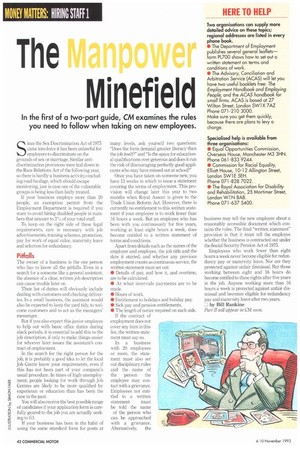The Manpnwpr
Page 44

If you've noticed an error in this article please click here to report it so we can fix it.
Minefield
In the first of a two-part guide, CM examines the rules you need to follow when taking on new employees.
Since the Sex Discrimination Act of 1975 came into force it has been unlawful for employers to discriminate on the grounds of sex or marriage. Similar antidiscrimination provisions were laid down in the Race Relations Act of the following year, so there is hardly a business activity,vincluding road haulage, which should escape monitoring, just in case one of the vulnerable groups is being less than fairly treated.
If your business employs more than 20 people, an exemption permit from the Employment Department is required if you want to avoid hiring disabled people in numbers that amount to 3% of your total staff.
To keep on the right side of these legal requirements, care is necessary with job advertisements, training schemes, promotion, pay for work of equal value, maternity leave and selection for redundancy.
Pitfalls
The owner of a business is the one person who has to know all the pitfalls. Even in a search for a someone like a general assistant, the absence of a clear, written job description can cause trouble later on.
Their list of duties will obviously include dealing with customers and checking deliveries. In a small business, the assistant would also be expected to keep the yard tidy to welcome customers and to act as the managers' messenger.
But if you also expect this junior employee to help out with basic office duties during slack periods, it is essential to add this to the job description, if only to make things easier for whoever later issues the assistant's contract of employment.
In the search for the right person for the job, it is probably a good idea to let the local Job Centre know your requirements, even if this has not been part of your company's usual procedure. In times of high unemployment, people looking for work through Job Centres are likely to be more qualified by experience or education than has been the case in the past.
You will also receive the best possible range of candidates if your application form is carefully geared to the job you are actually seeking to fill.
Ti your business has been in the habit of using the same standard form for posts at many levels, ask yourself two questions: "Does the form demand greater literacy than the job itself?" and "Is the space for educational qualifications over-generous and does it run the risk of discouraging perfectly good applicants who may have missed out at school?"
Once you have taken on someone new, you have 13 weeks in which to issue a statement covering the terms of employment. This provision will change later this year to two months when Royal Assent is given to the Trade Union Reform Act. However, there is currently no entitlement to this written statement if your employee is to work fewer than 16 hours a week. But an employee who has been with you continuously for five years, working at least eight hours a week, does become entitled to a written statement of terms and conditions.
Apart from details such as the names of the employer and employee, the job title and the date it started, and whether any previous employment counts as continuous service, the written statement must set out: • Details of pay, and how it, and overtime, are to be calculated.
• At what intervals payments are to be made.
• Hours of work.
• Entitlement to holidays and holiday pay.
• Sick pay and pension entitlements.
• The length of notice required on each side.
If the contract of employment does not cover any item in this list, the written statement must say so.
In a business with 20 employees or more, the statement must also set out disciplinary rules and the name of the person the employee may contact with a grievance. Employees not entitled to a written statement must be told the name of the person who can be approached with a grievance. Alternatively, the business may tell the new employee about a reasonably accessible document which contains the rules. The final "written statement" provision is that it must tell the employee whether the business is contracted out under the Social Security Pension Act of 1975.
Employees who work fewer than eight hours a week never become eligible for redundancy pay or maternity leave. Nor are they protected against unfair dismissal. But those working between eight and 16 hours do become entitled to these rights after five years in the job. Anyone working more than 16 hours a week is protected against unfair dismissal and becomes eligible for redundancy pay and maternity leave after two years.
11 by Bill Rankine Part ii will appear in CM soon.




























































































